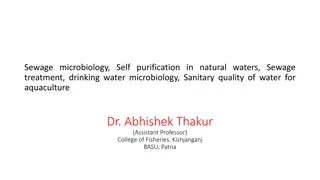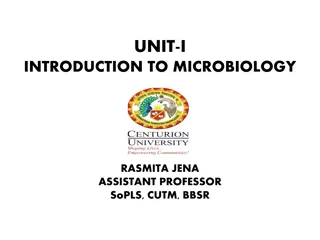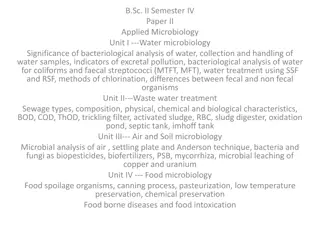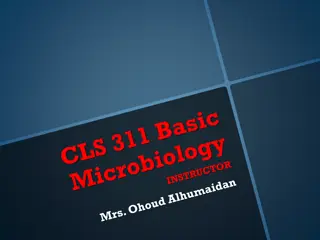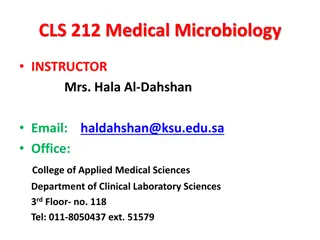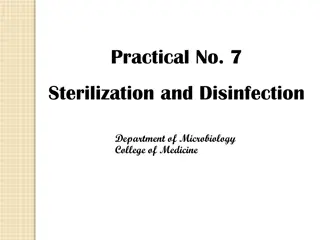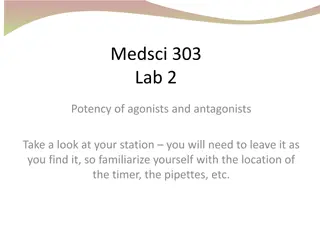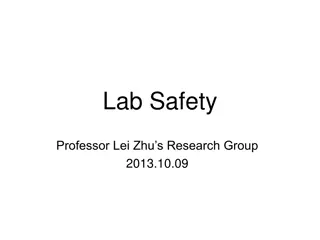
Sexually Transmitted Infections: Microbiology Laboratory Insights
Explore the microbiology laboratory findings in a case of urethritis suggestive of sexually transmitted infections like Chlamydia and Gonorrhea. Learn about common bacterial pathogens, methods for diagnosis, and specimen collection guidelines for accurate testing and treatment. Early detection is crucial in reducing complications associated with these infections.
Download Presentation

Please find below an Image/Link to download the presentation.
The content on the website is provided AS IS for your information and personal use only. It may not be sold, licensed, or shared on other websites without obtaining consent from the author. If you encounter any issues during the download, it is possible that the publisher has removed the file from their server.
You are allowed to download the files provided on this website for personal or commercial use, subject to the condition that they are used lawfully. All files are the property of their respective owners.
The content on the website is provided AS IS for your information and personal use only. It may not be sold, licensed, or shared on other websites without obtaining consent from the author.
E N D
Presentation Transcript
Microbiology Laboratory Week 2
The Patient Naser G. Age: 21 The clinical presentation suggests urethritis, commonly present in sexually transmitted infections such as Chlamydia and Gonorrhoeae
Common Bacterial Pathogens Neisseria gonorrhoeae o Intracellular, gram-negative, cocci bacteria Usually seen in pairs o Contains pili that aid adherence o 0.6-1.0 m in diameter o Incubation period of 2-6 days Commonly infect the cervix, urethra, rectum, pharynx, and conjunctiva N. gonorrhoeae
Common Bacterial Pathogens Chlamydia trachomatis o Non-motile, obligate intracellular bacterium Elementary Bodies: non-replicating, infectious o 0.24-0.3 m, rigid cell wall, DNA genome and plasmid o Released from ruptured infected cells Reticulate Bodies: Non-infectious, form in the cytoplasmic vacuole of elementary bodies o 0.5-0.6 m o Hemagglutinin facilitates cell adhesion o 18 serovars A-K serovars limited to surface o D-K associated with urinary tract infections L serovars are invasive C. trachomatis
Less Common Bacterial Pathogens Mycoplasma genitalium o Gram negative, flask shaped o 0.2-0.7 m o Contains ribosomes, plasma membrane, double-stranded circular DNA o Contribute to nongonococcal urethritis, cervicitis, and pelvic inflammatory disease Ureaplasma urealyticum o Gram negative cocci o No cell wall o Produces urease o 0.2-0.8 m, spherical M. genitalium U. urealyticum
Methods for Diagnosing a Sexually Transmitted Infection Urethral Smear o Massage the urethra from proximal to distal o plastic loop Urine Sample o Standard for STI testing o Non-invasive; preferred by patients The microbiology laboratory is important to determine cause and treatment of the infection Early detection and treatment can reduce complications
Specimen Guidelines Urethral Swab Urine Sample Collection: - Patients should not pass urine >2 hours prior Rotate 1-2 times 2-4cm inside the urethra - Patients should not pass urine 1-2 hours prior to collection 10ml of first catch urine - - Transport: - In swab specimen transport tube at 2-30 C - Transported in a properly labeled container with secure lid Storage: - Keep frozen up to -70 C, up to 60 days - Keep refrigerated at 2- 8 C up to 30 days
Laboratory Tests Culture Tests Non-Culture Tests - Gram stain - Giemsa stain - - Thayer Martin agar - Mycoplasma agar - Mccoy cell monolayer Differential media - Immunoassay - - Oxidase - Catalase test - Acid production test Biochemical tests - - Nucleic Acid Amplification test Molecular tests
Gram Stain Crystal violet (basic dye) Adding iodine (mordant), forms an insoluble complex Alcohol wash for decolourization Safranin counterstain Results: o Purple = Gram-Positive o pink = Gram-negative Gram stain of N. gonorrhea
Thayer Martin Agar 2.0g beef extract 17.5g casein hydrolysate 1.5g starch 17.0g agar dissolved in 1 liter of distilled water, pH adjusted to neutral at 25 C 5% chocolate sheep blood Results: o N. gonorrhoeae shows growth o C. trachomatis will not show growth Presence of N. gonorrhoeae
Mycoplasma Agar 10.0 g/L Bacteriological peptone 10.0 g/L Lab-Lemco powder 5.0 g/L Sodium chloride 0.5 g/L Mineral supplement 10.0 g/L Agar Results: o N. gonorrhoeae shows no growth o C. trachomatis shows no growth o M. genitalium shows growth
McCoy Cell Monolayer Tests for Chlamydia trachomatis Labour-intensive, slow and expensive o other non-culture detection methods Results: o N. gonorrhoeae shows no growth o C. trachomatis shows growth C. Trachomatis on McCoy monolayer
Oxidase Determines if a bacterium contains Cytochrome C oxidase tetramethyl-p-phenylenediamine turns purple when oxidized Results: o Positive = purple Purple indicates positive for N. gonorrhoeae o Negative = no colour change o Positive for aerobic bacteria Presence of N. gonorrhoeae
Catalase Test Detects the ppresence of the enzyme catalase H2O2 H2O + O2 Results: o The presence of N. gonorhhoeae will produce bubbles (+) o The presence of C. trachomatis will produce bubbles (+) Presence of N. gonorrhoeae
Acid Production Test Phenol red will change colour if an organism produces sufficient amounts of acid by utilizing glucose Results: o N. gonorrhoeae indicated by yellow o Other bacteria indicated by red Presence of N. gonorrhoeae
Giemsa Stain Can be used to detect C. trachomatis Stain contains azure II-eosin, azure II-glycerin, and methanol Results: o C. trachomatis indicated by purple colour
Immunoassay Bacterial antigen can be detected using antibodies Antibody binds to LPS on bacterial cells Substrate is added to a specimen and the product is measured Results: o Presence of C. trachomatis will be indicated by a positive result
Direct Fluorescent Antibody Uses antibodies to detect bacterial antigens Fluorescent dye attaches to antibody o Detects LPS on bacteria Results o Will be positive in the presence of N. gonorrhoeae and C. trachomatis Presence of C. trachomatis
Nucleic Acid Amplification Test Amplification and detection of the RNA/DNA of the bacteria Looks for specific base pair sequences Results: o Can detect N. gonorrhoeae and C. trachomatis


